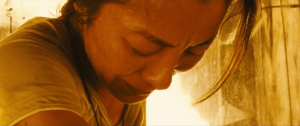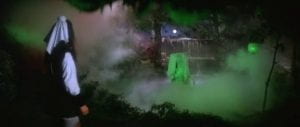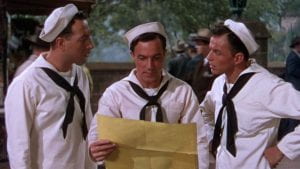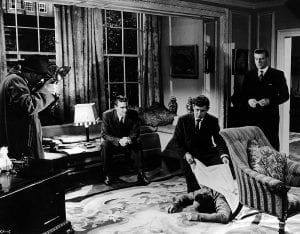Every month, A Place for Film brings you a selection of films from our group of regular bloggers. Even though these films aren’t currently being screened at the IU Cinema, this series reflects the varied programming that can be found at the Cinema and demonstrates the eclectic tastes of the bloggers. Each contributor has picked one film that they saw this month that they couldn’t wait to share with others. Keep reading to find out what discoveries these cinephiles have made, as well as some of the old friends they’ve revisited.
Jack Miller, contributor | Full Moon Scimitar (1979)
This month I’ve dedicated some of my time to exploring the glories of the Hong Kong wuxia film — a swordplay genre that was once very popular in that action-oriented film industry. The most famous wuxia directors are probably King Hu (Dragon Inn, A Touch of Zen), whose elegantly choreographed films gave the genre a serene classical precision, and, a little later on, Tsui Hark (The Blade, Green Snake) who updated the genre with his kinetic, “revisionist” wuxia films of the 1990s. Another, more neglected figure in wuxia history is the great Chor Yuen, whose best known for his wonderful The Sentimental Swordsman (1977) as well as an arty sexploitation piece called Intimate Confessions of a Chinese Courtesan (1972).
Less well known but quite interesting is Chor’s moody, expressionistic and haunted wuxia of 1979, Full Moon Scimitar. The film is a kind of ghost romance in the vein of works like The Ghost and Mrs. Muir (1947) and Brigadoon (1954), dealing with an underdog swordsman who learns to become a powerful fighter while residing in the spirit realm with his beloved, a “fox ghost.” The real highlight of Full Moon Scimitar is its otherworldly colors and set design: gothic temples shrouded in fog, neon gel lighting techniques straight out of a Bava movie. There’s a peculiarly bitter tone throughout, and Chor’s preference for blurring out portions of the frame with a strange, gauzy haze has lead the critic Sean Gilman to note that his films resemble “Sternbergian comic strips.” This film and several other key Chor Yuen films are streaming on Prime Video in their original Mandarin language.
Jesse Pasternack, contributor | DekaDonen 1: Dekalog: One (1988) and On the Town (1949)
My friend Mark Cousins once suggested that people learning how to make films should alternate watching all ten one-hour films that formed Kryzstof Kieslowski’s serious yet transcendent Dekalog (which are very loose adaptations of the Ten Commandments) with ten films directed by Stanley Donen, who was most famous for directing joyous musicals. I loved the idea of putting Kieslowski’s solemn yet hypnotic ethical tales in conversation with Donen’s upbeat musicals and comedies so much that I programmed a series that did just that. For the next ten months I will be watching that series — which I am calling the “DekaDonen” — and writing about my thoughts and feelings related to it. It’s fitting that my first double feature — Dekalog: One and On the Town — both provide similar answers to the same question: “How do you begin a work of art?”
The first moments of Dekalog: One and On the Town both involve a single, solitary male character. In the somber Dekalog: One, that figure sits in a snowy landscape as he stares into a fire before wiping what looks like a tear off of his face. In contrast, the male character in the beginning of On the Town sings a song as he walks to work on the docks. Both moments give the viewer an idea of what they are about to see — respectively a heartbreaking drama and a vivacious musical — and remind them of how important it can be to set the tone of a work of art as early as you can.
Despite their differences in tone, Dekalog: One and On the Town share some interesting similarities. They both take place over a short period of time: two days and nights in Dekalog: One and 24 hours in On the Town. They both take a passing interest in using film form to portray human consciousness, as evidenced by Kiewslowski’s beautiful point-of-view shots from the perspective of a child named Pawel and two fantasy sequences that Gene Kelly’s character Gabey imagines in On the Town. They were also both important beginnings for their directors because Dekalog: One was the first episode of the series that would bring Kieslowski international fame while On the Town was the first film that Donen directed (albeit with Kelly being credited as a co-director).
I felt like I learned so much from watching this first pairing. I look forward to seeing what else I can learn from watching combinations of Dekalog episodes and Donen’s films.
You can view a trailer for Dekalog here.
Laura Ivins, contributor | Sunshine (2007)
Years away from Earth, a handful of astronauts travel on a probable suicide mission to save our dying sun. The atmosphere is strangely both isolating and intimate, with each character contending with the solitude of their own piece of the mission, while also navigating the sometimes tense, but also close-knit, social situation of life aboard a spaceship years on end.
Like other films from director Danny Boyle and writer Alex Garland, Sunshine’s biggest strength is the psychological depth of the characters. Boyle and Garland worked together previously on 28 Days Later, and Garland has made a name for himself by writing and directing psychologically complex science fiction like Ex Machina, Annihilation, and Devs.
For this film Boyle and Garland went through dozens of drafts of the script, with the filmmakers and actors taking special care to think through the internal logic of each character and how the increasingly tense situation would impact the crew members’ interactions with each other. The science is not always realistic, but the strength of the performances, believability of the characters’ arcs, and the beauty of the visual style make this film fascinating to watch.
Michaela Owens, Editor | The Teckman Mystery (1954)
When I saw Muriel Box’s 1955 comedy Simon and Laura last year, I quickly discovered that Box was one of two women working as a director of feature films in Britain at that time. The other was Wendy Toye, a choreographer and dancer who made only six films and a few shorts in the ’50s and ’60s before going on to work in television and theatre. Although it’s proven tough for me to get my hands on most of Toye’s (and Box’s) movies due to their unavailability in the U.S., TCM came to the rescue — as it so often does — by airing The Teckman Mystery, a fantastic mystery that illustrates how unfair it is that Toye has become such a forgotten figure in film history.
Unexpectedly fast-paced and full of twists both big and small, The Teckman Mystery follows author Philip Chance (John Justin), whose publisher wants his next book to be about Martin Teckman, a young pilot who recently died while testing a plane. Chance isn’t that enthused about the idea — he is more intrigued by Teckman’s attractive sister, Helen (Margaret Leighton) — but it soon becomes clear there is much more to the pilot’s death than meets the eye. I won’t say anymore because that’s all I knew about the plot when I first watched the movie, and it made the experience so much better as I fell in love with Justin’s charming performance, Toye’s suspenseful, assured direction, and the delightful script.
If we’re being honest, I was hesitant to make this my pick for the month because it is not an easy film to track down. (It’s going to be a sad day when it expires from my DVR.) It’s been released on a region-2 DVD, but I had no success in finding it anywhere else or in any other format. However, despite this, I still felt it important to put Wendy Toye on your radar because trust me when I say I’m thrilled that she’s now on mine.
Unfortunately, there doesn’t seem to be a trailer, and the only video I could find is this brief clip from a scene between Chance and his publisher:




